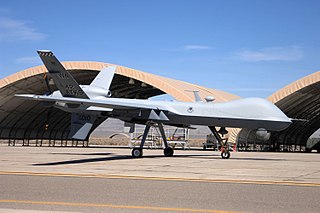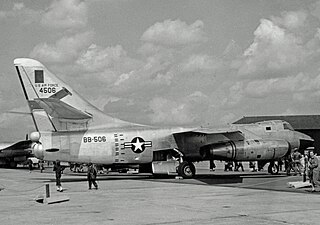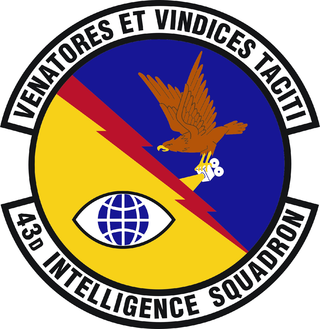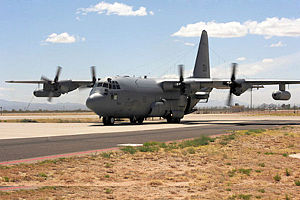
Davis–Monthan Air Force Base is a United States Air Force base 5 miles southeast of downtown Tucson, Arizona. It was established in 1925 as Davis–Monthan Landing Field. The host unit for Davis–Monthan AFB is the 355th Wing assigned to Twelfth Air Force (12AF), part of Air Combat Command (ACC). The base is best known as the location of the Air Force Materiel Command's 309th Aerospace Maintenance and Regeneration Group, the aircraft boneyard for all excess military and U.S. government aircraft and aerospace vehicles.

The 67th Cyberspace Operations Group is a unit of the 67th Cyberspace Wing. Headquartered on Kelly Field Annex's Security Hill, the group is an Air Force information operations unit.

The 11th Attack Squadron is a United States Air Force unit assigned to the 432d Wing Air Combat Command at Creech Air Force Base near Indian Springs, Nevada. It flies General Atomics MQ-9 Reaper Unmanned aerial vehicles. In 1995 the 11th became the first Remotely Piloted Aircraft (RPA) squadron in the Air Force.

15th Attack Squadron is a United States Air Force unit assigned to the 432d Wing, 732nd Operations Group at Creech Air Force Base near Indian Springs, Nevada. It flies the General Atomics MQ-9 Reaper remotely piloted aircraft.

The 26th Information Operations Wing is an inactive United States Air Force unit. Its last assignment was with United States Air Forces in Europe at Ramstein Air Base, Germany, where it was inactivated on 5 July 2006.

The 43rd Fighter Squadron is part of the 325th Fighter Wing at Tyndall Air Force Base, Florida. It conducts advanced fighter training for F-22 Raptor pilots.

The 432nd Wing is a United States Air Force unit assigned to Air Combat Command at Creech Air Force Base near Indian Springs, Nevada. It flies General Atomics MQ-9 Reaper and RQ-170 Sentinel Unmanned aerial vehicles.

The 78th Attack Squadron is an Air Force Reserve Command (AFRC) unit under the 926th Wing, Nellis Air Force Base, Nevada and Tenth Air Force at Naval Air Station Joint Reserve Base Fort Worth, Texas. The 78 ATKS conducts operations from Creech Air Force Base, Nevada in conjunction with their active-duty associates in the 432d Wing.

The 19th Electronic Warfare Squadron is an active United States Air Force unit, stationed in Bann, Germany as part of the United States Air Forces in Europe Warrior Preparation Center. It was first activated during World War II as the 19th Photographic Mapping Squadron. During the war, the squadron remained in the United States and mapped areas of North America. However, starting in 1944, the air echelon of the squadron deployed to North Africa to map that area. After V-E Day, the squadron moved to England and mapped large areas of Europe until October 1945, when it began to stand down for inactivation. It was briefly active in the reserve from 1947 to 1949 as the 19th Reconnaissance Squadron.

The 16th Electronic Warfare Squadron is an active United States Air Force unit. It is assigned to the 350th Spectrum Warfare Group at Eglin Air Force Base, Florida. The squadron began as the 16th 16th Aero Squadron and redesignated several times over its history with the 16th Aero Squadron, 16th Reconnaissance Squadron, and the 16 Photographic Reconnaissance Squadron being the major redesignations.

The 69th Reconnaissance Group is an inactive United States Air Force that was part of Air Combat Command, the group was stationed at Grand Forks Air Force Base, North Dakota where it was a tenant of the 319th Air Base Wing.

The 65th Special Operations Squadron is an Air Force Special Operations Command unit which flies the General Atomics MQ-9 Reaper at Hurlburt Field, Florida. The squadron was first activated as the 65th Bombardment Squadron in January 1941, one of the original squadrons of the 43rd Bombardment Group. Following the attack on Pearl Harbor, the squadron participated in antisubmarine patrols until January 1942, when it moved to Australia and the Southwest Pacific Theater. It moved forward with US forces through New Guinea and the Philippines, moving to Ie Shima shortly before V-J Day for operations against Japan. It earned two Distinguished Unit Citations and a Philippine Presidential Unit Citation for combat operations. During this period, a crew from the 65th became the most decorated aircrew in United States history, when their B-17 fought off twenty Japanese fighters during a photo reconnaissance mission. The squadron was inactivated in the Philippines in April 1946.

The 41st Electronic Combat Squadron is a United States Air Force unit. Its current assignment is with the 55th Electronic Combat Group at Davis–Monthan Air Force Base, Arizona as a geographically separated unit from its parent wing, the 55th Wing at Offutt Air Force Base, Nebraska. It operates the Lockheed EC-130H Compass Call communications-jamming aircraft.

The 101st Bombardment (Photographic) Squadron is an inactive United States Air Force unit. It was last assigned to the XIX Tactical Air Command, based at Brooks Field, Texas, in 1944. It was inactivated on 25 December 1945.

The 53rd Electronic Warfare Group was a component of the 53rd Wing of the Air Force Warfare Center, Air Combat Command, headquartered at Eglin Air Force Base, Florida.

The 3rd Special Operations Squadron flies MQ-9 Reaper Remotely Piloted Aircraft and is currently located at Cannon Air Force Base, New Mexico. The squadron is under the command of the Air Force Special Operations Command.

The United States Air Force's 25th Air Support Operations Squadron is an Air Force Special Warfare unit located at Wheeler Army Airfield, Hawaii. The squadron provides tactical command and control of air and space assets to the Joint Forces Air Component Commander and Joint Forces Land Component Commander for combat operations.

The 622d Expeditionary Air Refueling Squadron is a provisional United States Air Force unit, assigned to United States Air Forces Europe to activate or inactivate as needed. The squadron was first established during World War II as the 22d Photographic Reconnaissance Squadron. It served in the European Theater of Operations, where it earned a Distinguished Unit Citation and a French Croix de Guerre with Palm for its actions in combat.

The 22d Intelligence Squadron is a non-flying squadron of the United States Air Force. It is assigned to the 691st Intelligence, Surveillance and Reconnaissance Group, Fort George G. Meade, Maryland.

The United States Air Force's 43d Intelligence Squadron is an intelligence unit located at Cannon Air Force Base, New Mexico. It provides intelligence support to Air Force Special Operations Command.
























